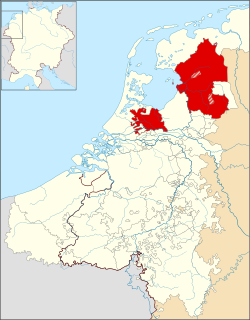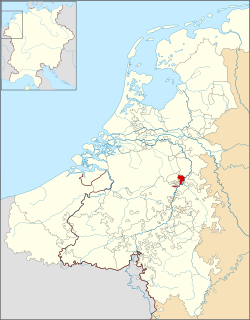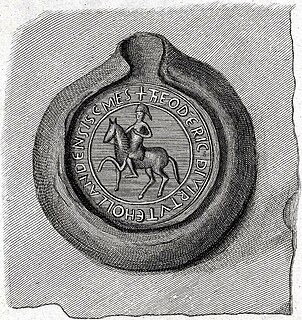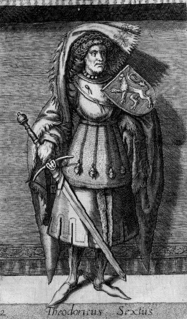Related Research Articles

The Bishopric of Utrecht was an ecclesiastical principality of the Holy Roman Empire in the Low Countries, in the present-day Netherlands. From 1024 to 1528, as one of the prince-bishoprics of the Holy Roman Empire, it was ruled by the bishops of Utrecht. The Prince-Bishopric of Utrecht must not be confused with the Diocese of Utrecht, which extended beyond the Prince-Bishopric and over which the bishop exercised spiritual authority.

The counts of Holland ruled over the County of Holland in the Low Countries between the 10th and the 16th century.

The Hook and Cod wars comprise a series of wars and battles in the County of Holland between 1350 and 1490. Most of these wars were fought over the title of count of Holland, but some have argued that the underlying reason was because of the power struggle of the bourgeois in the cities against the ruling nobility.

The County of Holland was a State of the Holy Roman Empire and from 1433 part of the Burgundian Netherlands, from 1482 part of the Habsburg Netherlands and from 1581 onward the leading province of the Dutch Republic, of which it remained a part until the Batavian Revolution in 1795. The territory of the County of Holland corresponds roughly with the current provinces of North Holland and South Holland in the Netherlands.

Horne is a small historic county of the Holy Roman Empire in the present day Netherlands and Belgium. It takes its name from the village Horn, west of Roermond. The residence of the counts of Horne was moved from Horn to Weert in the 15th century.

Dirk V was Count of Holland from 1061 to 1091.

Dirk VI was Count of Holland between 1121 and 1157, at first, during his minority, under the regency of his mother Petronilla. He was the son of Count Floris II. After his death he was succeeded by his eldest son Floris III. He married Sofie of Salm, Countess of Rheineck and Bentheim. She was heiress of Bentheim, which she ruled together with her husband and which was inherited by the couple's second son Otto after his parents' death.
Dirk VII was the count of Holland from 1190 to 1203. He was the elder son of Floris III and Ada of Huntingdon.
Dirk III was the count with jurisdiction over what would become the county of Holland, often referred to in this period as "West Frisia", from 993 to 27 May 1039. Until 1005, this was under regency of his mother. It is thought that Dirk III went on pilgrimage to the Holy Land around 1030, hence his nickname of Hierosolymita.

The (First) Battle of Vlaardingen was fought on 29 July 1018 between troops of the Holy Roman Empire and West Frisia. As a result of a trade dispute, Emperor Henry II sent an army towards West Frisia to subdue the rebellious Count Dirk III. However, the Imperial army was decisively defeated and fled in panic.
William I was bishop of Utrecht between 1054 and 1076. He was a typical representative of the German imperial system in which bishops were the main officials of the empire. He was a loyal follower of king Henry IV of Germany. William was appointed when a war was going on against West Frisia, which was resisting imperial authority. The imperial army conquered large parts of West Frisia in 1061, when Dirk V became count. King Henry gave the whole county to the bishopric of Utrecht in 1064. The whole of West Frisia was conquered in 1076 with the help of duke Godfrey III.
Otto I of Guelders (1150–1207) was a Count of Guelders and Zutphen from 1182 until his death in 1207. He was a son of Duke Hendrik of Guelders and Agnes of Arnstein. He married Richardis of Bavaria in 1184. Richardis was a daughter of Otto I Wittelsbach, Duke of Bavaria.

Frisian freedom was the absence of feudalism and serfdom in Frisia, the area that was originally inhabited by the Frisians. Historical Frisia included the modern provinces of Friesland and Groningen, and the area of West Friesland, in the Netherlands, and East Friesland in Germany. During the period of Frisian freedom the area did not have a sovereign lord who owned and administered the land. The freedom of the Frisians developed in the context of ongoing disputes over the rights of local nobility.
Arnoldvan Isenburg was Bishop of Utrecht from 1196 to 1197.
Dirk van Holland was bishop of Utrecht in 1197.

Wilbrand of Oldenburg was a bishop of Paderborn and of Utrecht.
Floris the Black was a son of Floris II, Count of Holland and Petronilla of Lorraine. He became a rebel count of Holland in the 1120s and 1130s, against the claim of his brother Dirk.
The historic diocese of Utrecht (695–1580) was a Roman Catholic diocese and archdiocese in the Low Countries before and during the Protestant Reformation.
References
- Rose, Hugh James (1857). "Are, Dirk van". A New General Biographical Dictionary. London: B. Fellowes et al.